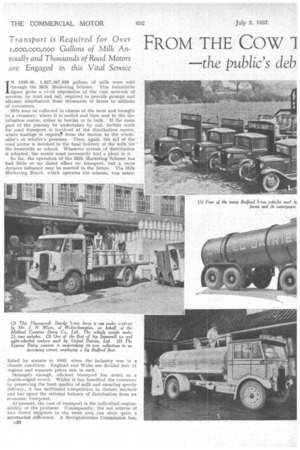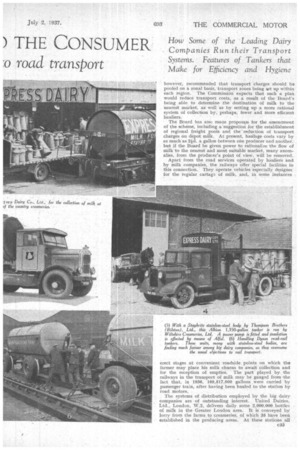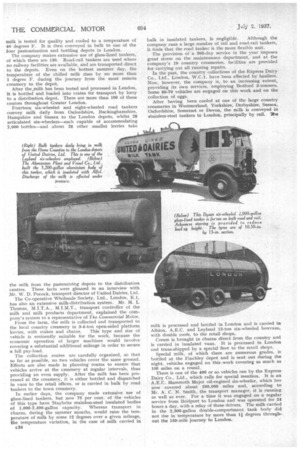FROM THE COW ) THE CONSUMER —the public's deb :0 road transport
Page 78

Page 79

Page 80

Page 81

If you've noticed an error in this article please click here to report it so we can fix it.
Transport is Required for Over i,000,000,000 Gallons of Milk Annually and Thousands of Road Motors are Engaged in this Vital Service How Some of the • Leading • Dairy -Companies Run their Transport Systems. Features of Tankers that Make for Efficiency and Hygiene
I N 1935-36, 1,027,267,558 gallons of milk were sold
• through the Milk Marketing Scherne. This formidable figure gives a vivid impression of the vast network of .Services, by road and rail, required to provide prompt and .efficient distribution from thousands of farms to millions
of consumers, : • • • • .
Milk may be collected in churns at the farm and brought to aCreamery, where it is codled-andthen sent to the distributioncentre, either in bottles or in balk. If the main 'part Of the journey be undertaken by rail, farther work for' road fransport is involved at the distribution ..centre, 'where-hair:lige. is require from the Staff= to the whole-: . saler's or retailer's premises. Then; again, the aid of the 'road 'motor is iroinked in the final 'delivery of the milk for the houSeWife or school: Whatever 'System of distribution is adopted, the motor mrist•necessarily find a place M it'.
• So far,' the operation of the Milk Marketing Scheme has had little or no direct effect on transPort, hut a inure decisive influence maybe; exerted in the future.' The Milk Marketing Board, which operates the, scheme, was estab
lished by statute in 1933, when the industry was in a chaotic condition. England and Wales are divided into 11 regions and separate prices rule in each.
Strangely enough, efficient transport has acted as a double-edged sword. Whilst it has benefited the consumer by preserving the fresh quality of milk and ensuring speedy delivery, it has facilitated competition in distant markets and has upset the rational balance of distribution from an economic viewpoint.
At present, the cost of transport is the individual responsibility of the producer. Consequently, the net returns of two direct suppliers in the same area can shoW quite a substantial difference. A Reorganization Commission has, e32 however, recommended that transport charges should be pooled on a zonal basis, transport zones being set up within each region. The Commission eXpeOts that such a plan would reduce transport costs, as a result of the Board's being able to determine the destination of milk to the nearest market, as well as by setting up a more rational system of collection by, perhaps, fewer and Mote effiCient hauliers.
The Board has also mane proposals for the a.mennment of the scheme, including a'suggestion for the establishment of regional freight pools and the 'reduction of transport charges on depot milk. At present, haulage costs vary by as much as 2-id. a gallon between one producer and another, but if the Board be given power to rationalize the flow of milk to the nearest and most suitable market, many anomalies, from the producer's point of view, will be removed.
Apart from the road Services operated by hauliers and by milk companies, the railways offer. special facilities in this connection.. They operate vehicles 'especially designee for the regular .cartaga of enillc and, in some instances
erect stages at convenient roadside points on which the farmer may place his milk churns to await collection and for the reception of empties. The part played by the railways in the transport of milk may be gauged from the fact that, in 1936, 169,517,000 gallons were carried by passenger train, after having been hauled to the station by road motors.
The systems of distribution employed by the big dairy companies are -of outstanding interest. United Dairies, Ltd., London, W.2, delivers daily some 2,000,000 bottles of milk in the Greater London area. It is conveyed by lorry from the farms: to creameries, of which 35 have been established in the producing areas. At these stations all
milk is tested for quality and cooled to a temperature of 40 degrees F. It is then conveyed in bulk to one of the four pasteurization and bottling depots in London.
The company makes extensive use of glass-lined tankers, of which there are 130. Road-rail tankers are used where no railway facilities are available, and are transported direct to the depots. Even on the hottest summer day, the temperature of the chilled milk rises by no more than 1 degree F. during the journey from the most remote creamery to the depot.
After the,milk has been tested and processed in London, it is bottled and loaded into crates for transport by lorry to a distribution depot. There are more than 100 of these centres throughout Greater London.
Fourteen six-wheeled and eight-wheeled road tankers convey milk daily from Oxfordshire, Buckinghamshire, Hampshire and Sussex to the London depots, whilst 28 articulated six-wheelers—each capable of accommodating 7,000 bottles—and about 28 other smaller lorries take the milk from the pasteurizing depots to the distribution centres. These facts were gleaned in an interview with Mr. W. D. Pocock, transport director of United Dairies, Ltd.
The Co-operative Wholesale Society, Ltd., London, E. I, has also an extensive milk-distribution system. Mr. M. I.
Thomas, M.I.T.A., transport controller of the milk and milk products department, explained the company's system to a representative of The Commercial Motor.
From the farm, the milk is collected and transported to the local country creamery in 3-4-ton open-sided platform lorries, with stakes and chains. This type and size of vehicle is eminently suitable for the work, because the economic operation of larger machines would involve covering a substantial additional mileage in order to secure a full pay-load.
The collection routes are carefully organized, so that so far as possible, no two vehicles cover the same ground. Efforts are also made in planning routes to ensure that vehicles arrive at the creamery at regular intervals, thus providing an even supply. After the milk has been processed at the creamery, it is either bottled and dispatched in vans to the retail offices, or is carried in bulk by road tankers to the town creamery.
In earlier days, the company made extensive use of glass-lined tankers, but now 75 per cent, of the vehicles of this type have Staybrite stainless-steel insulated bodies of 1,000-2,400-gallon capacity. Whereas transport in churns, during the summer months, would raise the temperature of milk by some 12 degrees over a given mileage, the temperature variation, in the case of milk carried in c34 bulk in insulated tankers, is negligible. Although the company runs a large number of rail and road-rail tankers, it finds that the road tanker is the more flexible unit.
The provision of a 365-day service in the year imposes great stress on the maintenance department, and at the company's 19 country creameries, facilities are provided for carrying out all running repairs.
In the past, the country collections of the Express Dairy Co., Ltd., London, W.C.I, have been effected by hauliers. Now, however, the company is, to an increasing extent, providing its own services, employing Bedford 3-tonners. Some 60-70 vehicles are engaged on this work and on the collection of eggs.
After having been cooled at one of the large country creameries in Westmorland, Yorkshire, Derbyshire, Sussex, Oxfordshire, Somerset or Devon, the milk is conveyed in stainless-steel tankers to Loudon, principally by rail. 3Nie milk is processed and bottled in London and is carried in Albion, A.E.C. and Leyland I2-ton six-wheeled boxvans, with double roofs, to the retail shops. Cream is brought in churns direct from the country and is carried in insulated vans. It is processed in London and trans-shipped by a special fleet to the retail shops. Special milk, of which there are numerous grades, is bottled at the Finchley depot and is sent out during the night, vehicles engaged on this .work covering as much as 100 miles on a round.
There is one of the 400 or so vehicles run by the Express Dairy Co., Ltd., which calls for special mention. It is an A.E.C. Mammoth Major oil-engined six-wheeler, which has now covered about 250,900 miles and, according to Mr. A. C. N. Smith, the transport manager, it is running as well as ever. For a time it was engaged on a regular service from Bridport to London and was operated for 24 hours a day, with a relay of three drivers. The milk carried in the 2,300-gallon double-compartment tank body did not rise in temperature by more than 1/ degrees throughout the 150-mile journey to London. Electrics play a big part in the company's retail distribution system, Eighty-six of these units are employed, and the Metro-Vick is being standardized.
Among the haulage companies providing regular services for the bulk transport of milk is Bulwark Transport, Ltd., Chepstow, This company runs a trunk service from various parts of Monmouthshire, Gloucestershire, Sornersetshire, Warwickshire, Wiltshire and Devon to London. Stainlesssteel insulated tankers with bodies by Thompson Brothers (Bilston), Ltd., Bilston, are employed and, so soon as the tank is filled, the vehicle sets off from Chepstow to London, a change of drivers being effected at Cheltenham. .
Arriving in town, the tanker is taken over by the dairy hands and the milk discharged shows a temperature variation of not more than 1 degree F., compared with that recorded in the dairy. The inside of the tank is thoroughly cleaned at the receiving depot, and the vehicle has ample time to return to Chepstow for the next day's work. There is an interesting story to be written around the constructional features of milk tankers. It seems that the
glass linedunit is new taking second place to the stainless.
. ..
steel vessel, which is far lighter. Tanks made of this metal range in capacity from 500-2,500 gallons, the 1,500-gallon size being the most popular.
It is essential that the interior of the tank be perfectly clean and that the surfaces be polished. The latter. requirement involves the careful grinding of welds, In most cases, Fin. steel is employed for constructional purposes, fittings being of the same material. The manhole lid is usually hinged and has a rubber joint ring. Agitators are sometimes fitted inside the tank for churning purposes. Most of the stainless-steel tanks are insulated, usually with Alfol enclosed in a sheet-aluminium sheath.
• One of the many interesting products of Thompson Brothers .(Bilston), Ltd., is a 2,300-gallon double-compartment elliptical stainless-steel tank body, equipped with power-driven pump and agitators. The insulating agent is Alfol. The basis of the vehicle, which has been supplied to Cow and Gate, Ltd., is a Thomyeroft six-wheeled chassis, Another noteworthy product is a 2,000-gallon single-compartmeut tank body mounted upon a Dyson road-rail trailer; the Alfol insulation is enclosed in altuninium-alloy sheeting.
Referring to the importance of low unladen weight, the: Aluminium Plant and Vessel Co., Ltd., London, SW. 18, points out that, by accommodating several hundreds of extra gallons of milk, an appreciable economy on long hauls may be effected._ A well-known concern, employing a growing fleet of milk tankers, says the A.P.V. Company, places the cost of delivery from one of its west-county depots to London at 1.125d. per gallon This dairy undertaking has recently purchased some new tankers, each of which carries several hundred more gallons than did the earlier models. On the basis of a 300-day year, the saving effected will be approximately R,140 for each additional 100 gallons of pay-load.
Truly a Leviathan of the road, an A.E.C. eight-wheeled chassis has recently been equipped with an A.P.V. 3,200gallon two-compartment tank, in which both the container itself and the sheath around the Alfol insulation are of aluminium. The discharge of milk is effected by pressure, air lines being connected to the nozzles on the maiuways. Actually, the capacity of the tank could have been increased to about 3,150 gallons had insulation been dispensed with, but this course is not advisable on long-distance work, although it may.safely be followed on short hauls.
An interesting vehicle, supplied by the Steel Barrel Go., Ltd., Uxbridge, to Keith Wright, Ltd., F.enstanton, Hunts, comprises a 2,000-gallon double-cornPartment tanker, With
provision at the front for carrying a number of churns. In common with most of the 1,400-gallon and 1,450-gallon' tankers supplied to Hornby's, .Dairies, Ltd., this vehicle has a stainless-steel body, lagged' with Alfol insulation and covered with aluminium sheeting. . The .body is mounted 011 the chassis by means of light fabricated steel bearers, with securing bands, and fixed by means of high-tensile
U-bolts.
In the sphere of road-rail tankers, R. A. Dyson and Co., Ltd., Liverpool; has had. wide experience. To the order of a well-known Liverpool concern owning dairies in Cheshire, the company has recently completed a trailer, tanker with a 1,000-gallon glass-lined body. Special coachbuilt b,oxes are provided at each end for the accommodation of churns, although they may also be used to carry extra milk, cream, etc. The vehicle is drawn by a Leyland equipped with a similar tank. Other recent products include a six-wheeled 2,000-gallon glass-lined road-rail tanker, mounted on 10,50-in. by 13-in. low-pressure tyres and incorporating Ackerman steering, and a 2,000-gallon Alfol-lagged stainless-steel tanker. Ackerman steering is also employed in the latter unit, but the tyres are of 12.00-in. by 20-in. section. It collects milk from farms and is transported by rail to the dairy in London. These are but a few of the interesting trailers manufactured by the Dyson concern for the haulage of milk.
The co-operation of manufacturers in the provision of scientifically constructed bulk-transport units is an important factor in raising the quality of milk sold to the public. Consumers probably do not realize the debt that they owe, to road transport in this connection, but the service rcnclered.by hygienic road vehicles in the rapid distribution of milk is undoubtedly one of the most notable contributions to public welfare.




















































































































































